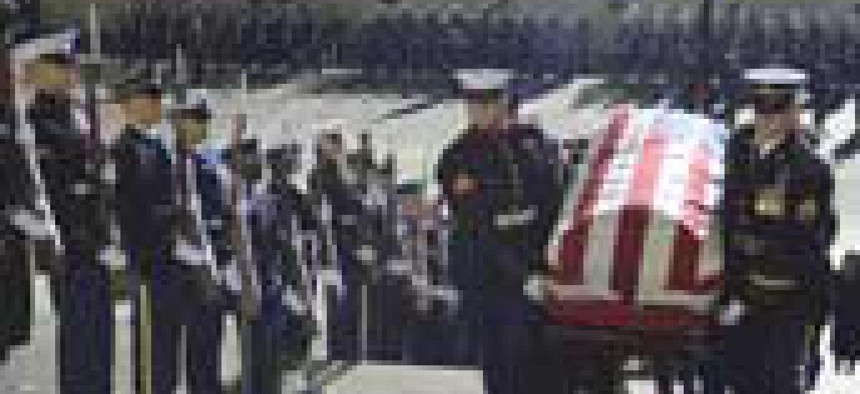In case of emergency: Share

New tools and standards ease the way for crisis centers to cooperate.
Notes scribbled onto whiteboards, colored pushpins dottingmaps and people yellingback and forth have often beenthe norm for emergency operationscenters during the heightof disasters.That's all changing now thatemergency management softwareis usurping the old, manualway of doing things, saidNadia Butler, chief executiveofficer of Emergency ServicesIntegrators, or ESi, whichdeveloped the emergency managementsystem WebEOC."What you find now whereWebEOC is implemented isthey are displaying WebEOCboards on the wall, replacingwhite boards," Butler said."We've got [geographic informationsystem] sections inWebEOC that replace the maps,and messaging and sharing ofreal-time information replacethe telephone calls and yelling.What we've heard from severalcustomers is that they areamazed how quiet the emergencycenter gets once theyfully implement WebEOC."Besides making emergencyoperating centers more orderly,the management systems helpjurisdictions and agencies handlecrises better and communicatewith one another moreeffectively.Although the systems havebeen around for years, expertsagree there are still plenty ofcustomers to go after."We figure only about 10 percentof the people who could beusing automated tools are usingthem," Butler said. "It's a very,very new market. We're stillconverting people from whiteboards and paper."One of the things that arehelping increase adoption ofemergency management systemsis that the software ismoving away from being noninteroperableto a more openformat.Interoperability problemsamong radio systems get moreattention, but the same problemexists in data systems, saidArt Botterell, community warningsystem manager at the sheriff's department in ContraCosta, Calif."So WebEOC was interesting,because it was really one of thefirst packages to shift towardusing standardized interfaces,? in their case, the HTTPinterface," Botterell said. "Bybuilding around that standard,they kind of let you plug andplay anything that can beexpressed as a Web page intotheir product framework."That kind of openness hashelped the industry flourish.One of the first big movestoward openness was theCommon Alerting Protocol, anExtensible Markup Languagestandard designed for exchangingalerts and warnings amongdifferent systems, such as sirensand weather radios.Now it has been applied tothings like sensor data forchemical and biohazards monitoringbecause it is a simple wayto transfer information aboutevents.Many of the vendors in theemergency management arenaformed the EmergencyInteroperability Consortium tochampion interoperableemergency communications.The group, forexample, promotes thedevelopment of Webservices and XML datainteroperability standards.Interoperability standardsare also a missionof Comcare, a nonprofitorganization dedicatedto advancing emergencycommunications.Environmental Support Solutions Inc.'sESS Crisis product hasbeen tested against theexisting standards, said JohnGargett, product manager forthe company, which is based inTempe, Ariz.The product features automatednotifications, task tracking,spatial information andmore for incident managementofficials.The industry seems to bebacking standards, but generaltechnology trends are also helpingwith interoperability,Gargett said."Technology has kind of takenover that concept with theincreased use of XML, which isthe basis for the Comcare standards,for example," Gargettsaid. "But primarily throughWeb services, it has become soeasy in today's world to createinteroperable systems."If neighboring jurisdictionshave different emergency managementproducts, and theywant to exchange or access thesame resource files, it can bedone through XML and Webservices. As long as two or morejurisdictions agree ahead oftime to share information, thedata can be made available duringan emergency.Other details also need to beaddressed to make the processwork smoothly: Are the filesavailable for read only? Doorganizations have to log in toeach other's systems? How dothey send the requests?ESi's WebEOC is, as thename suggests, Web-based crisisinformation managementsoftware. It allows customers toshare information in real time,and it is configurable by thecustomer."The product can be configuredto match how they dothings rather than having aprocess imposed on them by thesoftware, which is probably oneof its most powerful aspects,"Butler said."We'll find that when we goback to a user's site after a yearor so, the product at one sitewill look completely differentthan it does at another customer'ssite," she said.It enables sharing of information,messaging and postingand tracking tasks. WebEOC islicensed on a per-server basis,and each customer can decidewho has access to the system.The software is used heavilyin the Washington area. It wasused, for example, to help coordinatethe funeral of formerPresident Gerald R. Ford.The company plans to makethe system even moreinteroperable in futureversions, Butler said."What we're workingon now is a way to linkall of those WebEOCsystems together sothey can all interact,"Butler said, "so thatyou'll have the abilityto share informationacross jurisdictions asopenly as people arewilling to."In the next versionof WebEOC, organizationswill be able tolink to any third-partysoftware.So if an organization wants tolink to alerting software, plumemodeling software or somebodyelse's crisis information managementsoftware platform,they will be able to have anadapter to do that.That kind of interoperabilityis what customers want and ishow most future systems willlikely operate, Botterell said."Modular decompositionfixes the interoperability issue,"he said. "Where we say, 'OK,you guys can compete with yourproprietary products, but all werequire is that at certain definedinterfaces, you must utilize anopen standard so we can interoperateand compete technologiesfreely.' "

COMMON ISSUES
THE FINE PRINT
Staff Writer Doug Beizer can be reached at dbeizer@1105govinfo.com.

A military honor guard carries former President Ford's casket into the House of Representatives at the Capitol in Washington Dec. 30, 2006. WebEOC software helped the city coordinate its efforts by enabling agencies to share information in real time.
BlackStar photos
COMMON ISSUES
THE FINE PRINT
Staff Writer Doug Beizer can be reached at dbeizer@1105govinfo.com.
NEXT STORY: On the edge

